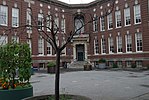House at 17 Cranston Street
Houses completed in 1871Houses in BostonHouses on the National Register of Historic Places in Suffolk County, MassachusettsJamaica Plain, BostonNational Register of Historic Places in Boston

The House at 17 Cranston Street in the Jamaica Plain neighborhood of Boston, Massachusetts, is an architecturally eclectic and distinctive 12-sided structure, with an unusual combination of Italianate and Gothic features. It was built around 1874 by two Scottish immigrants, and is a distinctive landmark overlooking Hyde Square. It was listed on the United States National Register of Historic Places in 1987.
Excerpt from the Wikipedia article House at 17 Cranston Street (License: CC BY-SA 3.0, Authors, Images).House at 17 Cranston Street
Cranston Street, Boston Jamaica Plain
Geographical coordinates (GPS) Address External links Nearby Places Show on map
Geographical coordinates (GPS)
| Latitude | Longitude |
|---|---|
| N 42.321 ° | E -71.109416666667 ° |
Address
Cranston Street 17
02130 Boston, Jamaica Plain
Massachusetts, United States
Open on Google Maps









